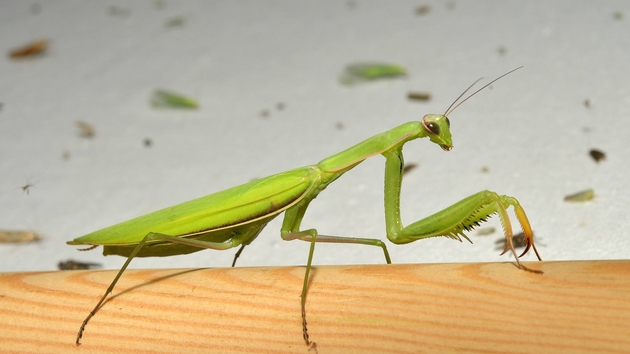There is one species of mantis in Poland, the common mantis – Mantis religiosa. This, so far rare insect, since 1984 has been subject to strict protection, it is listed in the Polska Czerwona Księga Zwierząt (Polish Red Book of Animals) in the EN category (highly endangered).
At the end of the 20th century, the mantis appeared in Poland locally and the Sandomierz Basin constituted the northern limit of its occurrence. Since 2000, the number of the praying mantis has begun to gradually increase and new sites of its occurrence appeared. Over the last dozen or so years, but especially since 2015, the range of the praying mantis in Poland has increased significantly. The mantis is currently rare only in the north of our country.
Prof. Agnieszka Soszyńska-Maj from the Department of Invertebrate Zoology and Hydrobiology, University of Lodz says:
This year we are witnessing a rapid expansion of the praying mantis in Central Poland. My attention was particularly drawn by their relatively high number in the centre of a large city, which is Lodz. In the last few years, I only heard about single sightings of this insect in our city. I have personally come across a mantis in Lodz for the first time this year in the Botanical Garden. However, last week I received numerous reports on the occurrence of praying mantis within the area of Lodz. I get information on this subject from my friends, I observe intensification of posts on FB, both on groups of nature enthusiasts, nature photography enthusiasts, but also among the inhabitants of our city.
And she adds:
We ask residents on social media to join the project of creating a map of the occurrence and the list of observation of the praying mantis in and around Lodz. In other words, to capture the sudden occurrence of this unusual insect in our city. If someone notices a mantis in an apartment, on a balcony, in a park, in a meadow, on a plot, in a garden, please take a photo of it (if possible) and write the place and date in the post on Facebook on the website of the Lodz Branch of the Polish Entomological Society. Alternatively, you can also contact me – as the coordinator of the action – by e-mail (agnieszka.soszynska@biol.uni.lodz.pl).
What has led to such a rapid increase in the number of these insects in Lodz? It seems that the combination of factors such as: progressive warming of the climate, record temperatures this summer, recent mild winters, the phenomenon of the "urban heat island", which Lodz undoubtedly is, but according to prof. Agnieszka Soszyńska-Maj, also intensification of the flower meadows project, which probably are becoming the city's praying mantis refuge.
We would like to remind you that the mantis is an insect that is subject to strict legal protection. Despite its large size, it cannot do any harm to a human. Therefore, under no circumstances should the praying mantis be interfered with, it must not be bred or its cocoons with eggs removed. If a mantis flies into our apartment or car, carefully take it out to a safe and quiet place.
The mantis is, as for our fauna, a large insect, females can reach up to 9 cm. These predators use their characteristic prehensile legs of the first pair to hunt for larger insects, usually locusts and grasshoppers. Praying mantis are quite voracious, although despite the widespread belief that females eat males, in fact only less than 30% of cases of mating end up with eating the male. Adults appear from August to October. After mating, females attach ooteka to the plants – cocoons with 100-200 eggs, from which the larvae emerge after wintering. Praying mantis are highly thermophilic insects, they occur naturally in dry and warm mid-forest meadows, grasslands, heaths, shores of pine forests, but also in wastelands and fallow lands. Their slender shape and light green or yellow-brown colour make them blend well with the surroundings and they are difficult to see in free nature.
Material: Dr hab. Agnieszka Soszyńska-Maj, Prof. of UL, Faculty of Biology and Environmental Protection of the University of Lodz, President of the Lodz Branch of the Polish Entomological Society
Edit: Promotion Centre, UL

